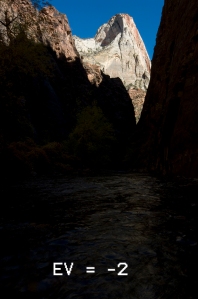I thought this was an interesting comparison, though by no means totally decisive as to which High Dynamic Range application one should purchase and use. I ran the same three exposures through three different HDR programs plus Photoshop CS3’s Merge to HDR function. I used the default settings on all of these apps, so as to keep the comparison as close to “apples-to-apples” as possible. Obviously, changing the parameters in the various programs could/would/should improve the output. Nonetheless, the default results are telling, though the story may be up for interpretation.
My original RAW exposures are at EV 0, EV+2 & EV-2. These then where processed accordingly:
- Photoshop CS3’s Merge to HDR function: one HDR output
- Unified Color’s HDR PhotoStudio 2: one HDR output
- Essential HDR, version 1: two outputs, one using the Details Revealed mode and the other using the Fast Tone Balancer mode
- Photomatix 3: three outputs using Tone Compressor, Details Enhancer and the non-HDR blending mode of Exposure Fusion
Looking at the original 3 exposures and then the Photomatix HDR outputs (all three!) it seems pretty clear to me that out of the proverbial starting gate Photomatix better positions your images. They have richer colors, more details, believable contrasts and less strange “HDR-like” artifacts. This is not to say that the other apps presented useless images (well, the Photoshop output was just plain terrible), but all of them would require more work in Photoshop to bring them into the same league with the Photomatix images.
Mind you: This was just one test. Other images with different contrast ratios and color schemes should be tried with the other applications (though not with Photoshop’s Merge to HDR…I’m done with that!) before one could definitively say who the winner would be of this HDR shootout. I’ll continue to explore the other apps and perhaps new ones as well. But I must say, for my HDR work, currently I’ll just be clicking on the Photomatix icon.










This comment has been removed by a blog administrator.
ReplyDeleteThis comment has been removed by a blog administrator.
ReplyDeleteThis comment has been removed by a blog administrator.
ReplyDelete